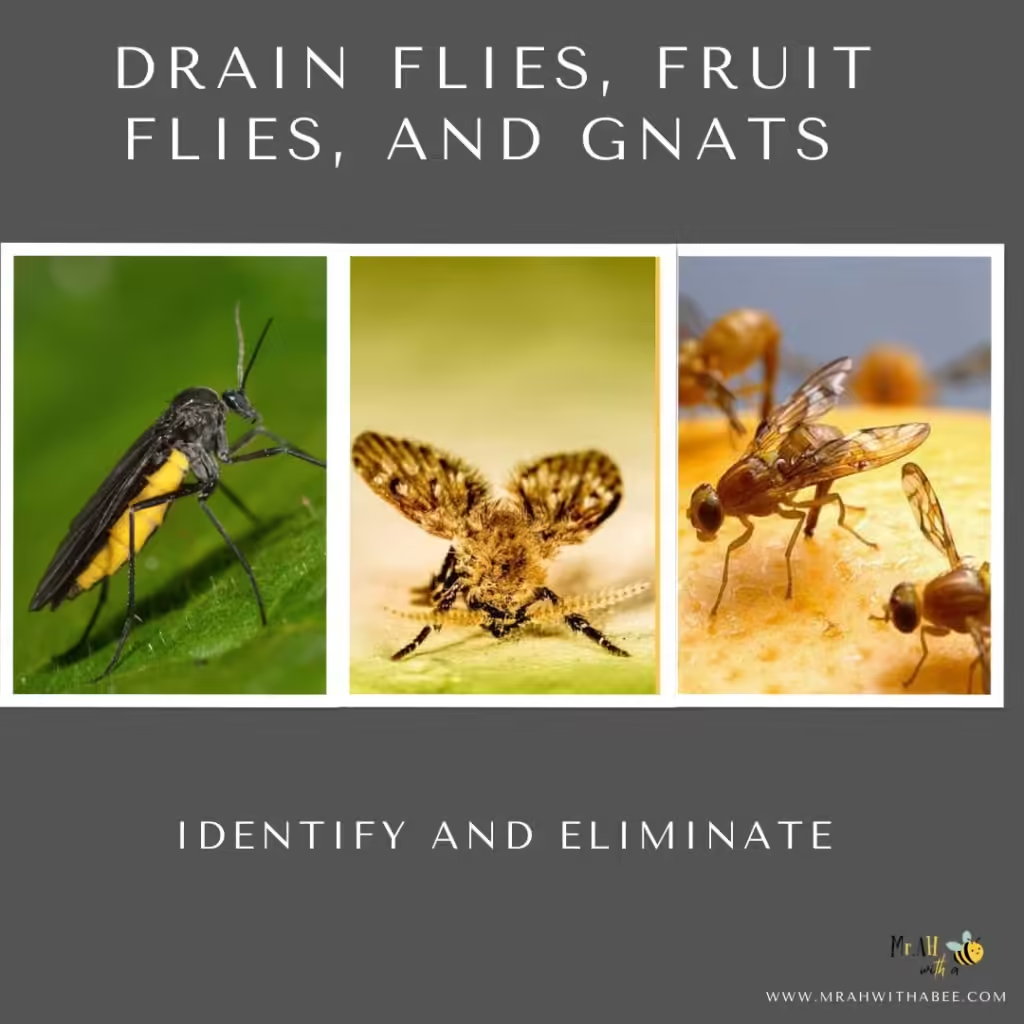What Are Drain Flies?
Drain flies also known as sewer or moth flies, are tiny insects that sometimes appear around drains. They become a nuisance by invading homes, restrooms in commercial buildings, sewage treatment plants, and agricultural facilities that handle moist animal waste. Due to their fuzzy bodies and long antennae, they resemble moth flies or both midges. These insects bear a resemblance to moths but can be distinguished by their two true wings with parallel veins. Adults can vary in color from dark gray to light tan, often having spots on their wings, and typically measure about 2-4 mm (1/16-3/16”) in length.
You’ll often find them in kitchens, bathrooms, bathtubs, showers, sinks, and floor drains where moisture is present. They breed in organic matter found inside the drains, especially in stagnant water. This environment is ideal for breeding, as the debris and moisture create a suitable habitat for larvae to thrive. Adult flies survive on water or flower nectar and live for about 12 days. They are weak fliers and tend to rest most of the time.
What Causes Drain Flies?
Drain flies are drawn to standing water and organic debris inside your drains. When the drains remain uncleaned for a while, they accumulate grime, algae, food particles, and other organic materials. This creates a perfect breeding ground for these insects. When the conditions are optimal, the female drain flies lay their eggs in the sludge that collects in the drains. The eggs will hatch into larvae that feed on organic matter, adding to the infestation. These flies naturally inhabit shaded areas with moist, decaying organic matter, such as wet woodlands or swamps.
Drain Fly Larvae
Drain fly larvae survive in polluted, shallow water or moist organic matter. Their eggs, larvae, and pupae can be found in the bacterial muck, slime, or gelatinous film that builds up inside drains, overflow pipes, septic tanks, and wet compost. They also dwell in dirty garbage containers, rain barrels, and tree holes.
The eggs are laid by the females in moist environments and they hatch within 32 to 48 hours at 70ºF. The larvae feed on decaying organic matter, bacterial films, algae, and sediment in these moist environments. Their maturation occurs within a span of 9 to 15 days, and they play a crucial role in the purification of sewage water and the decomposition of waste.
The larvae breathe by extending tube-like tails to the surface and live in drain pipes or wet organic matter. Pupae form on or near the breeding substrate, and new adults emerge after 20 to 40 hours.
How Do Drain Flies Build Their Nests?
Drain flies breed in organic material inside drains, not constructing traditional “nests” like birds or bees. Instead, the larvae survive in the sludge that accumulates in drain pipes. The sludge typically consists of food particles, grease, and other decaying matter, creating an ideal environment for development.
They can be challenging for thorough cleaning because these breeding grounds are hidden within pipes. To prevent infestation and remove buildup, it is important to conduct regular maintenance. If drains are overlooked, organic material can build up, creating a suitable environment for drain flies to lay their eggs and for larvae to flourish.
Types of Drain Flies
Drain flies, also known as moth flies or filter flies, belong to the family Psychodidae. They thrive in humid and damp environments, making drains an ideal breeding ground for them. They are commonly found in bathrooms, kitchens, and basements with higher moisture levels.
Here are some common types:
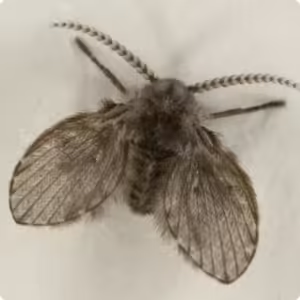
- Moth Flies (Psychoda spp.): These flies are easy to recognize because of their fuzzy bodies and moth-like appearance. They thrive in moist environments and are commonly found in sewage systems and drains.
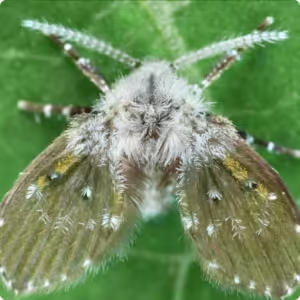
- Sewer Flies (Clogmia albipunctata): These insects are commonly found in wastewater treatment plants and areas with stagnant water. They are characterized by a unique light gray color with white spots on their wings.
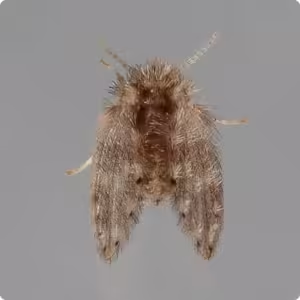
- Bathroom Flies (Psychoda alternata): These are named for their frequent presence in bathrooms, these flies are attracted to the organic matter found in sinks and showers.
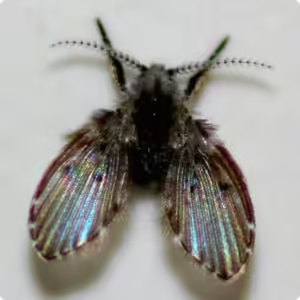
- Filter Flies (Clogmia albipunctata): These flies are often associated with sewage treatment facilities and can be found in areas where water is filtered, such as ponds or lagoons.
Drain flies of all types share similar breeding habits, thriving in damp environments abundant in decaying organic material. Consistent cleaning and maintenance can effectively control their population.
Are Drain Flies Harmful?
The drain flies are not harmful to humans. They are typically seen as a nuisance in homes, they are not inherently unsanitary. They do not seek out human food, do not bite or sting humans or animals, and do not pose a threat to agricultural or ornamental plants. However, their presence indicates unsanitary conditions as it suggests a source of moist organic material in nearby stagnant water.
In the wild, drain flies consume organic matter, aiding in water purification, and they are a food source for many small insect-eating animals, both as larvae and adults.
How to Get Rid of Drain Flies
- To eliminate drain flies, it’s essential to remove the food sources for their larvae, disrupting their development and preventing the emergence of more adult flies.
- Common breeding sites include sink drains, toilets, floor drains, tub drains, and leaky shower pans, where organic matter can accumulate in dark, damp conditions.
- One of the most effective methods to get rid of drain flies is to thoroughly clean the drain.
- Use a stiff brush to scrub the inside of the drain pipe, which will help remove the organic material where the flies breed.
- Pouring boiling water down the drain is another effective way to kill both the flies and their larvae. Repeat this several times a day to keep the problem under control
- You can also use a natural or chemical drain cleaner to break down the organic material. Enzyme-based cleaners are particularly good options, as they are non-toxic and effectively decompose organic matter without harsh chemicals.
- If you’re uncertain which drain is harboring the flies, cover the drain opening with a piece of tape at night, sticky side facing down. In the morning, check the tape for flies; this simple test can help you identify the source of the infestation.
What are Fruit Flies
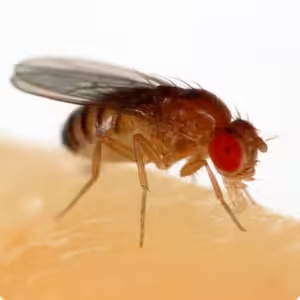
Fruit flies (Drosophila melanogaster) are small insects often found near ripe and rotting fruits and vegetables. They are drawn to fermented liquids like wine and vinegar. With their red or black eyes and tan bodies, they are easy to recognize. They quickly invade kitchens, restaurants, and even drains with their tiny size.
How to Get Rid of Fruit Flies in the Drain
Fruit flies and drain flies are different insects, but both can appear in your home if your drains are dirty. Here are some effective ways to get rid of fruit flies:
- Remove Food Sources: Remove any overripe or decaying fruits and vegetables. Store fresh produce in the refrigerator to avoid attracting flies.
- Trap Fruit Flies: You can easily create a homemade trap by pouring apple cider vinegar into a jar and covering it with plastic wrap. Poke small holes in the wrap, allowing the flies to enter the jar but preventing them from escaping.
- Clean Drains: Fruit flies can breed in moist areas like drains. Pour boiling water or use a drain cleaner to eliminate breeding grounds.
- Use Insecticide: If the infestation persists, using a mild insecticide spray may help reduce their numbers.
Drain Flies vs. Fruit Flies
What Are Gnats and How to get rid of them
Gnats are tiny flying insects that can be annoying in homes and gardens. They often hover around food, plants, or drains. Although small, these pests can create frustrating swarms. It’s important to address a gnat infestation, as they can spread bacteria, damage plants, and become overwhelming if not managed properly.
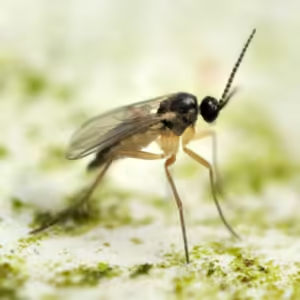
What Are Gnats?
Gnats belong to various families and typically thrive in damp environments, attracted to moisture, organic matter, and decaying food. While the term ‘gnat’ encompasses several types of small flies, the most common varieties include:
- Fungus Gnats (Bradysia spp.): These gnats thrive in moist soil and often fly around potted plants, making them common in houseplants.
- Black Gnats (Sciaridae): Like fungus gnats, these small, dark flies are drawn to damp environments and decaying organic matter.
- Buffalo Gnats (Simulium spp.): These are larger than typical gnats and are known for their painful bites. They are often found near rivers and streams.
-
Sand Flies (Phlebotomus spp.): Found in sandy areas, these gnats can bite and are known to transmit diseases in some regions.
-
Eye Gnats (Hippelates spp.): These small flies are attracted to the moisture around the eyes and often become a nuisance, especially in warm weather.
Gnats have a short life cycle, usually transitioning from eggs to adults within a few days. This rapid development enables them to multiply quickly if not dealt with promptly.
Identifying Gnats
Gnats are usually very small, measuring about 1/8 inch in length. They are typically black, brown, or yellowish. Here’s how to identify different types:
- Fruit Flies: These small, reddish-brown insects with red eyes often gather near fruits or fermenting food.
- Fungus Gnats: Darker in color with long legs, they are commonly found near potted plants or damp soil.
- Drain Flies: Tiny, moth-like flies with furry wings, often seen near drains or standing water.
Common signs of gnat infestation include the presence of small swarms around decaying food, damp soil, or moist drains. You often find these insects near sources of food or water, which are essential for their breeding and survival.
Causes of Gnat Infestations
Here are the most common causes of gnat infestations:
- Moist Soil or Plants: Fungus gnats thrive in overwatered plants or damp soil.
- Garbage and Compost: Unsealed garbage or exposed compost can serve as a breeding ground for gnats.
Environmental conditions like high humidity, warm temperatures, and lack of proper ventilation can further encourage gnat infestations.
How to Get Rid of Gnats
1. Prevention Strategies
Preventing a gnat infestation is easier than dealing with one after it starts. Here are some preventive measures.
- Keep Food Covered and Stored Properly: Keep food stored in an airtight container, and avoid leaving out ripe fruits or leftovers exposed.
- Regular Cleaning and Waste Disposal: Take out the trash regularly, keep your kitchen area clean, and make sure there are no spills or crumbs.
- Manage Moisture Levels in Plants and Soil: Avoid overwatering houseplants and ensure proper drainage to prevent fungus gnats from laying eggs in damp soil.
2. DIY Removal Methods
If you already have a gnat infestation, here are some effective home remedies to help get rid of them.
- Vinegar Traps: Mix vinegar and dish soap in a shallow dish. The scent of the vinegar attracts the gnats, while the soap traps them.
- Fruit Traps: Place overripe fruit in a jar, cover it with plastic wrap, and poke small holes. Gnats will be attracted to the fruit and become trapped inside.
- Essential Oil Sprays: Create a spray using essential oils like peppermint, tea tree, or eucalyptus. You can spray these oils around entry points as natural repellents.
3. Store-Bought Solutions
If home remedies are not enough, there are commercial solutions available.
- Commercial Gnat Traps: These often contain bait or glue that attracts and traps gnats.
- Gnat Sprays: Insect sprays designed for indoor use can be effective in killing gnats quickly.
FAQs
Thank you for reading, for more interesting articles visit our homepage.
If you are interested in more articles about flies visit All About Wasp Nests: Types, Removal, and How They Are Built and The Fascinating World of Butterfly Wings

